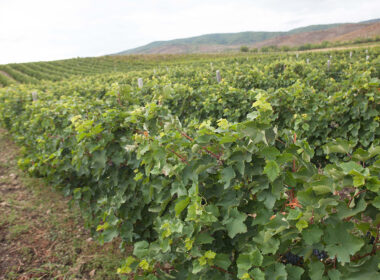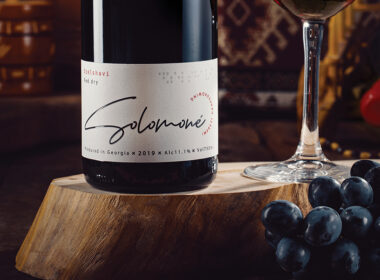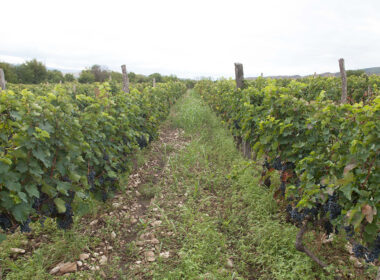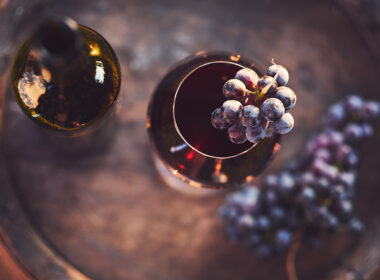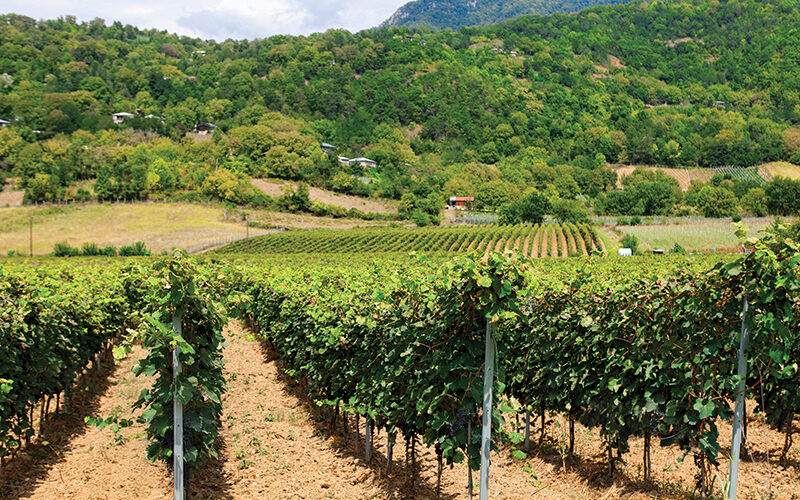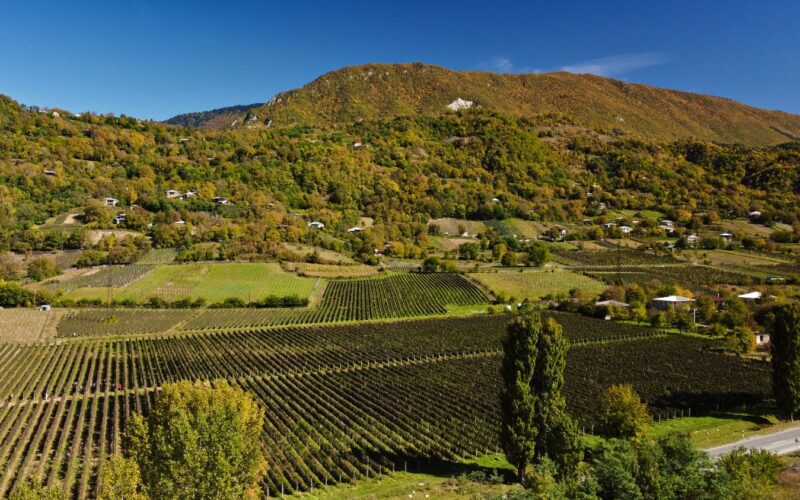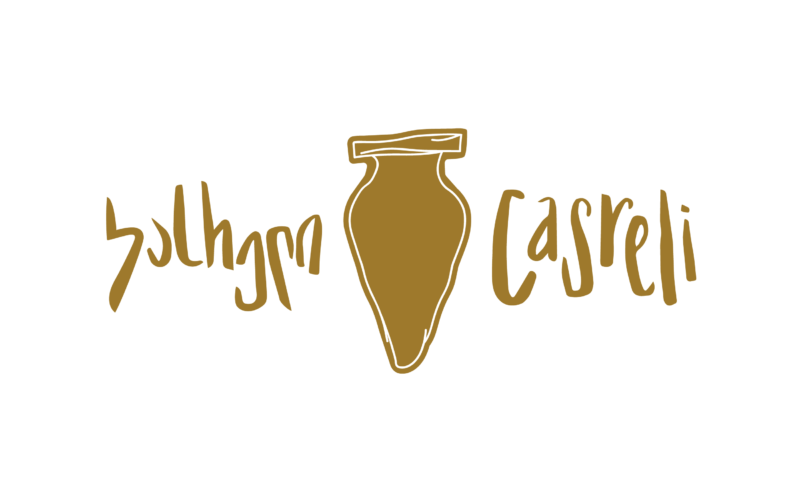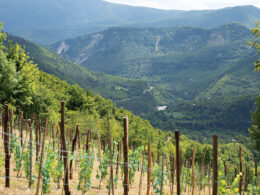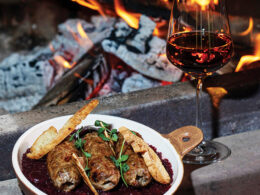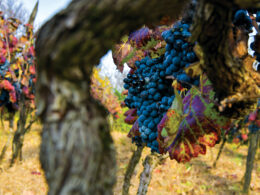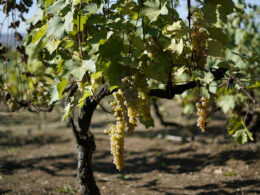Hemmed by the Greater Caucasus Mountains, Racha is located between Racha and Lechkhumi Ridges, in the Valley of the Rioni River. It is famous for its exceptional beauty and wonderful wine. Here, vineyards spread on both sides of the Rioni River, but occupy only about 800 hectares (for comparison, vineyards in the Kakheti region occupy around 30 000 hectares). The most prominent grape varieties of Racha – Aleksandrouli and Mujuretuli – make up only 1/3 of the total amount.
Despite the small number of vineyards, Racha is as popular for its wine as any other region in Georgia. Local wines have always been high in demand, and you can certainly notice it during the harvest: around October, after all the grape is collected in Kakheti, people head to Racha, and the region gets very busy with wine professionals and wine lovers.
Historically, there were much more vineyards in Racha than there are today. Sources indicate that at the end of the 19th century their area was around 3000 desyatinas (a measuring unit used before the metric system), which is a bit more than 3000 hectares. Some sources suggest this number to be closer to 5000 hectares. According to later sources, the total area of vineyards in Racha by the 1950s was 3200 hectares, which made winemaking a rather lucrative affair for locals.
Past numbers can only mean one thing: there is a potential for more vineyards in Racha, which would greatly contribute to its economic growth and well-being.
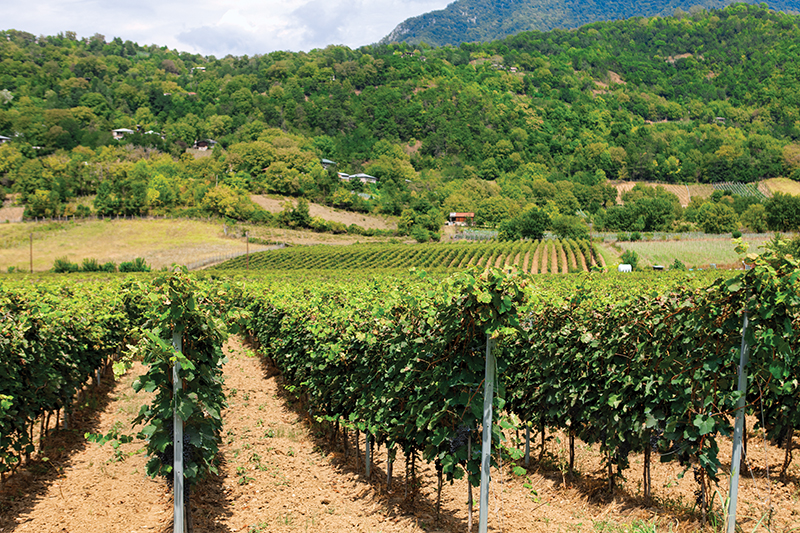
Micro zones of Racha, its soil, and climate
Racha is divided into two municipalities of Oni and Ambrolauri, or, when it comes to winemaking, simply Upper and Lower Racha. Upper Racha or Oni district, is in a mountainous zone and winemaking gives way to other agricultural activities, such as livestock farming.
Most vineyards are located lower, stretching from Oni to Ambrolauri district, and this is exactly where the potential lives when it comes to winemaking and tourism. To this day, Khvanchkara is the most famous wine made from local grapes, however other varieties make for no less a wine than their famous counterparts. There are endemic varieties here that are worth mentioning, they produce light-bodied and truly unique tasting wines.
Vineyards in Lower Racha spread through both banks of the Rioni River, 450-800 meters above sea level. Historically, the right bank is called the Khvanchkara micro-district, and the left is known as Ambrolauri-Bugeuli micro-district. Wines taste different depending on which side was the grape grown on.
Vineyards on the right bank fall on the southern side; they get sunlight throughout the day. Villages on this side, such as Tola, Khvanchkara, Chorjo, Bostana, were historically known for their grape varieties. This is the land where local grapes Aleksandrouli and Mujuretuli grow, and this is home to Khvanchkara or Kipianis’ wine.
Consequently, vineyards on the left bank of the river are on the northern side. Grapes here get less sunlight, but the temperature remains high, so the grapes mature just as easily. This side (so-called Bugeuli micro-district) is said to be better for white grape and Shavi (Black) Kapistoni growth. There are also some Aleksandrouli and Mujuretuli vines here. As we ascend through villages, the number of vineyards declines, since it gets harder for grapes to reach their maturity.
In terms of soil, Lower Racha has mainly humus-carbonate and clay soils as well as limy soil, flint mixed with clay, and sand with clay, which are ideal for quality wines. Climate is quite humid, but Rioni “ventilates” the area, so the chances of finding high humidity-related diseases are low. High ranges of Racha and Lechkhumi protect the valleys from excess wind and dramatic weather changes. The area gets lots of sunlight and warmth. All of this lets the grape take its time to mature and yield rich, complex, and versatile wine.
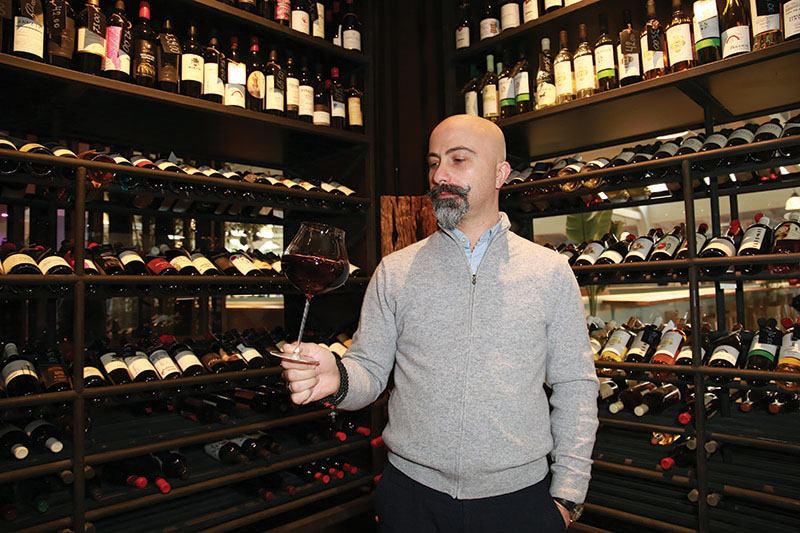
Giorgi Samanishvili | Oenologist |: The biggest interest for me is the 19th-century scriptures, where foreign winemakers describe Racha as a region with the most unique wines. They also extensively write about Kipiani wines. The history of “Khvanchkara” wine is inevitably related to the Kipiani family name. The family made exceptional wine as early as the ’70s of the 19th century and successfully sold it locally, as well as Kutaisi, later exporting it to different cities of the Russian Empire. Before the first World War, generations of the Kipiani family successfully made “Khvanchkara” wine. They even received a Grand Prix in 1907 on an international exhibition held in Ostend, Belgium. Kipiani wine received a diploma, a medal, and a coin featuring the King of Belgium. Today, this coin is kept in the National Museum of Georgia.
The writing on one of the labels of Kipiani wines is very curious. It reads: “Authentic Kipiani wine from Racha, from the lands of Aleksandre’s son Dimitri and Lurasab’s son Lursab, sold by Kutaisi wine merchants – Nestor Tsereteli and Varlam Papuashvili”. It is evident counterfeiting this wine was quite common and the names of the merchants served as the guarantee of its authenticity.
In 1920, “Khvanchkara Cooperative Winery” also started making wine along with the local population. They made it following Kipiani tradition, which was to make Khvanchkara by partial fermentation of fully ripe Aleksandrouli and Mujuretuli. During the same time, “Kipiani Wine” became “Khvanchara”. “Khvanchkara Cooperative Winery” was part of Georgia’s viticulture-winemaking cooperative union called “Georgian wine”, transferring to the State Department of Vine and Wine (“Samtrest”) in 1932.
Konstantine Modebadze’s research on what made Kipiani wine so unique is especially interesting. If we analyze all of the data that he collected, namely the alcohol within 13°, and almost 80 grams of sugar per liter, we can deduct that the grape was harvested at 27-30% maturity, in other words, very ripe, even slightly wilted. The wine, as a result, came out very dark and strong, giving it its unique characteristics.
The popularity of sweet and semi-sweet wines in the world is declining. This, of course, is not the case for sweeter wines from Protected Designations of Origin (PDO), such as Italian Recioto della Valpolicella, French Sauternes, German late harvest wines, and fortified Port, Sherry, or others. However, producers of these wines work very hard to maintain their popularity. I often cite the example of Valpolicella, the wine region in Veneto where naturally sweet red wine Recioto della Valpolicella is made from red Corvina and other grape varieties. They dry the grape after harvest to increase its sugar content. Raisin-like grapes are then pressed and fermented, however, the fermentation process is interrupted to get the famous red semi-sweet Recioto with no less than 12% alcohol content and 50 grams of sugar per liter. In 1950, local winemakers started making dry wine from grapes for Recioto, without decreasing their initial sugar content. What they got was high alcohol (14% according to specification, but 15% and more in practice), strong-scented and tasteful wine that they named Amarone. Today, red, high-alcohol, dry Amarone is more in demand than its red, sweet predecessor Recioto. I think this is a very good example of the rejuvenation of the image of wine, which certainly can take place in Racha.
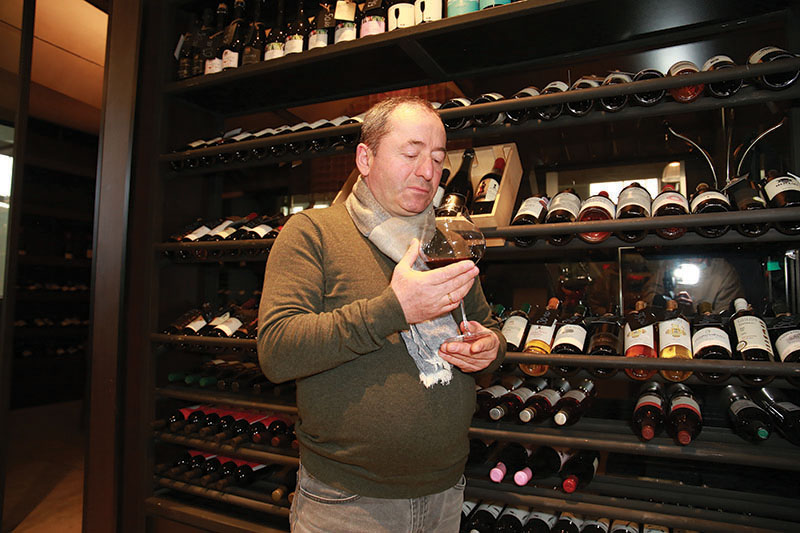
Kakhaber Gordeziani | “Barakoni Winery” |: There is a lot to do in Racha to accelerate and develop the production of other wines, besides semi-sweet. It is important to look at it from not only an economic but winemaking perspective.

Lado Uzunashvili | Owner of Mukado Wines; Chief Consulting winemaker at “Vazisubani Estates” and “Royal Khvanchkara” |: Let me also mention that Racha faces huge challenges in today’s political environment. Two main consumers of “Khanchkara” wine are Ukraine and Russia, and everyone is familiar with the current situation with these countries. We have to think about the future of this region and take actionable steps. It is crucial to once again look at soils, grape varieties, wine styles produced and analyze the techniques of winemaking. We have to outline what can be reprofiled and what future wines of Racha can potentially be. I’m almost certain that that “Khvanchkara” as we know it will not be able to gain a ground on Western markets.
There is no doubt that Racha has a great potential as a unique region of our Country. Modernity has always been a part of this region. I think that Racha’s survival is hidden within its originality, but in no way in its recent years’ legacy.
Grape varieties in Racha
The most prominent red grape varieties in Racha are Aleksandrouli and Mujuretuli, while Rachuli (or Tsulukidze) Tetra is the most famous in white grapes.
Endemic varieties of Aleksandrouli and Mujuretuli are quite similar. Some say that they have the same ancestry, namely a grape called “Old Aleksandrouli”, which spawned Aleksandrouli and Mujuretuli. A similarity between these two varieties can be found in their twigs, leaves, and cordons, but their berries are vastly different. Aleksandrouli berry is round, while Mujuretuli berry is elongated. Mujuretuli reaches its maturity a little bit earlier. While mature, the skin gets quite firm and pops nicely in the mouth. These two varieties were traditionally grown together in mixed vineyards. It is only for the last 10-15 years, winemakers have started to grow them independently.
Other red grapes in Racha include Imeretian Dzelshava, which yields a unique wine – simpler, but with an interesting, attractive aroma. Locals often refer to this variety as Dzvelshava.
Kakhetian Saperavi is also quite widespread here. It was brought to this region at the beginning of the 20th century to mix in with Khvanchkara. Saperavi grown in Racha yields a dark aromatic wine, which is softer and milder than traditional Saperavi. Another Imeretian variety found here is Otskhanuri Sapere. Some endemic varieties include – Shavi (Black) Kabistoni, Arabeuli, and Rtskhili (or Rtskhila). They are historically known as the most widespread varieties in this region.
As mentioned above, the most famous white grape variety here is Rachuli or Tsulukidze Tetra – a source of pride for locals. Demand for this variety is so high that it rarely gets bottled. The privilege of tasting it is awarded to locals or their very lucky guests.
Some other white grapes here include Imeretian Tsolikouri, Goruli Mtsvane (known here as Kvishkhura), Gorula, Tsitska, and other grapes, either local or brought from neighboring regions.
Lado Uzunashvili: We know for a fact that there are 66 endemic varieties in Racha.
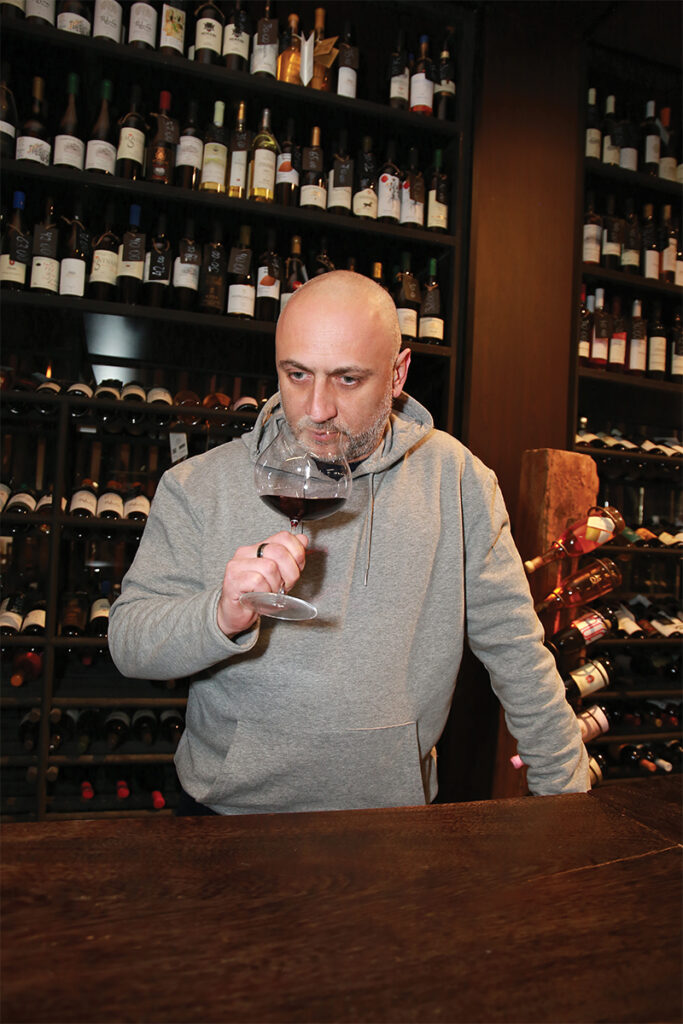
Giorgi Tevzadze | Winemaker. “Tevza Winery”, “Naberauli Winery” |: And only a few of them are grown in Racha. Take Shavi Kabistorni, for example, that only a few families grow. We managed to convince one of the nurseries to take its buds for their collection in Kakheti. These activities are very important for Racha.
Lado Uzunashvli: Worth mentioning a very interesting variety – Dzelshavi. We tried it to make rose wine. It turned out that it has great potential and can successfully compete with famous rose wines of the world, including Provence!
Giorgi Tevzadze: Incidentally, the Dzelshavi-Saperavi coupage is rather interesting.
Lado Uzunashvli: Indeed. I first combined Saperavi with Dzelshavi in 2004 and I got very interesting results.
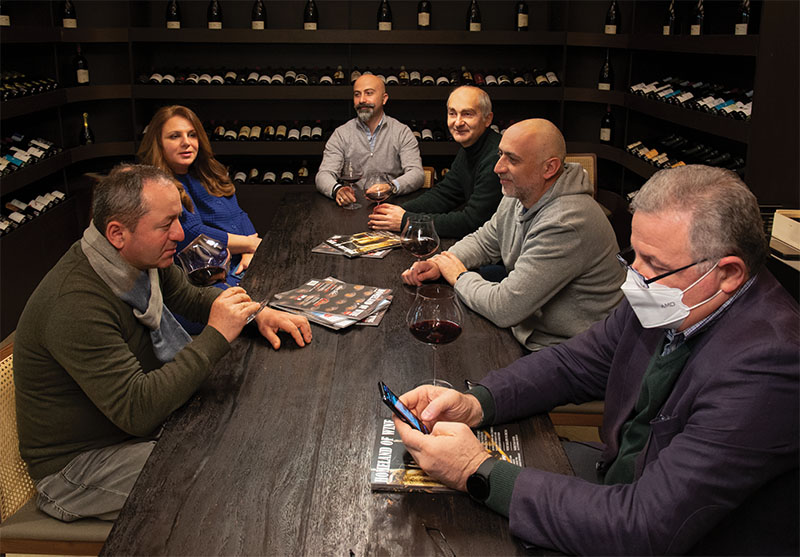
David Chichua | Profesor. Head of Scientific-Research Center of Jighaura|: There are high-quality terroirs in Racha with great potential. We have to agree on both the style and concept of their development. We also have to pay attention to the rare grape varieties of Racha that can yield interesting results, depending on where they are grown. Their volume is so low that it is hard to talk about their positioning on the world market. However, these varieties are very promising in terms of the development of local wine tourism. Another important aspect that we cannot neglect is mass-produced wines. The process of quality differentiation will certainly take place in Racha as it did in other winemaking regions. It is hard to make any types of forecasts at this point, but this will certainly take place at some point.
Giorgi Samanishvili: We have to mention Shavi Kabistoni and Saperavi when we talk about grape varieties of Racha. Saperavi was originally brought to Racha from Kakheti, but it has been grown here for centuries now. Traditionally, Saperavi was always used in coupage with Khvanchkara (I should say that all varieties have contributed to the complexity of this wine). As for Shavi Kabistoni – ampelographers of previous generations praise this variety, especially the one grown in the Bugeuli microregion.
David Chichua: In my experience, the Saperavi clone grown in Racha is one of the most interesting ones. Levan Jorjadze describes it and notes that there are various types of Saperavi and the best among them are the ones with red stalks. As far as I have observed, Saperavi grown in Racha has red stalks, whereas the stalks of Saperavi grown in Kakheti are distinctly green.
Kakhaber Gordeziani: I think it has to do with the soil. What oxidizes and what makes the stalks dark has to be carefully studied.
Lado Uzunashvili: To my best understanding we have to bring forward ways of intervarietal blending perspectives, when we talk about Racha. Meaning the co-fermentation of red and white varieties. This is not new to Racha, there is a grand tradition of it in the region – V. Kvatskhuti. The world has seen so many precedents of this technique and now we have a chance go back and adhere to this tradition, which has been almost forgotten. The governing regulations of our Industry have to be also brought into harmony with these new challenges. Mukado Wines make two wines of this concept: Saperavi-Mtsvane, and Saperavi-Khikhvi, and they are already in demand Worlwide. There are many examples of co-fermenting or assemblage in Europe, where red wine is produced this way, e.g. Syrah-Viognier. We, unfortunately, chose to ignore existing exaples and we called the final product “rosé”. I see it a mistake! Both co-fermentation and assemblage are explained by chemistry/biochemistry of grapes and wine, we have scientific proof as well as our history to back up this way.
Giorgi Samanishvili: In general, combining red and white grapes to make red wine is prohibited in many countries, except the PDOs where it is traditionally allowed. When making our legislation, we wrote out the first part of the sentence and omitted everything that came after the word “except”. So today, according to our legislation, combining red and white grapes to make rose wine is allowed, but making red is prohibited.
Lado Uzunashvili: I think it is wrong to call it rose.
Giorgi Samanishvili: I agree, especially because it is red wine.
Lado Uzunashvili: I don’t think it should have some sort of a coded name. The production should be correctly regulated. It can become an advantage for Racha.
Giorgi Samanishvili: And when these wines are back in the region, all wine prices in Racha will increase and there will not be such a strong attachment to the Russian market.
Giorgi Tevzadze: We are observing a very interesting trend in Racha today, namely the increase of dry red and white wine production. Small wineries are weary of producing only Khvanchkara, and they are actively growing the dry wine segment. Additionally, they experiment with different coupage, which is also important. I also want to stress that semi-sweet and sweet Racha wines are still considered dessert wines, which is detrimental to its image. These wines (even Tvishi) pair beautifully with different cuisines, including the Asian. It has to be acknowledged.
Lado Uzunashvili: I agree. There was a tradition in Kakheti to serve cold reds made with arrested fermentation with hot red meat dishes. It is so unfortunate that we forgot about this tradition.
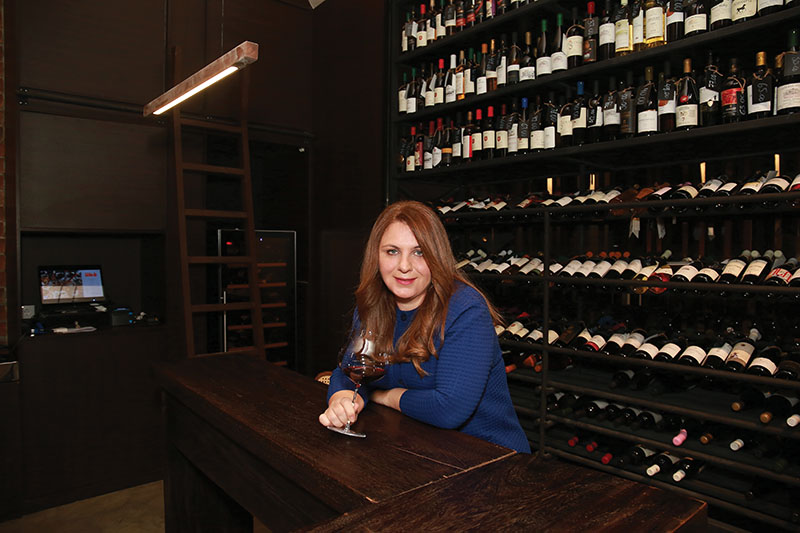
Sophia Lekishvili | “Tchrebalo Wine Cellar”|: We know that there is more demand for dry wines in the world markets. So, we actively started developing this line. As Racha’s calling card, “Khvanchara” holds a special place in “Tchrebalo Wine Cellar” assortment, but we also gave way to many interesting experiments. We created “Barakoni” wine, with a coupage of 4 grape varieties: Aleksandrouli, Mujuretuli, Dzelshavi, and Kabistoni. We also have dry Aleksandrouli, both the classical and qvevri versions. We expect them to be very interesting for European and American markets.
Although we carry mostly red wines in our assortment, white grape varieties such as Tsulukidze Tetra and Rachuli Mtsvane are also quite interesting. If dry, they yield a good, classic table wine. It would be very beneficial if we had a unified approach on matters such as promoting several Racha grape varieties with the purpose of their development in line with world market demands.
Giorgi Samanishvili: We all agree that Racha has immense potential compared to other winemaking regions of our country. Out of 10 viticulture regions, it is the smallest and well-bordered naturally. Even in the best-case scenario, the total area of vineyards here cannot exceed 3-4 thousand hectares. If we put in the work, in the world where wine popularity keeps increasing, these natural limitations paired with unique characteristics will automatically result in high-quality and high-price, which is the core strategy for Georgian wine.
Lado Uzunashvili: There is no shortage of terroirs in Racha. All of the components that make up a terroir, 80%, if not more, is soil. Even on the same terroir (administratively speaking), just 100 meters apart, the soil compound can be completely different, yielding a completely different wine. Racha has abundance of soil types. This advantage has to be utilized with great care. Grape varieties should also be selected with timing in mind.
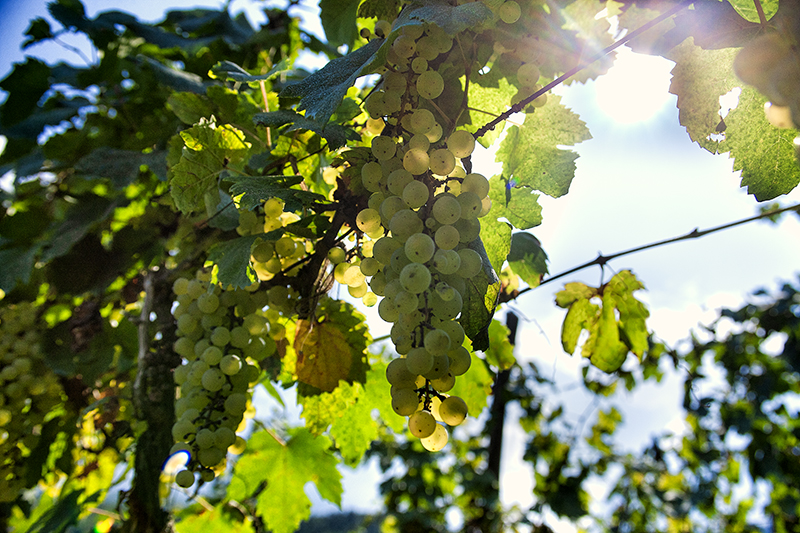
Kakhaber Gordeziani: I agree that we have to choose a specific route: for instance, select a few varieties that are sure to yield good results and work with them. This doesn’t mean that small wineries will not have the possibility to experiment with other varieties. It is crucial to conduct extensive research on how well the varieties will perform on a specific terroir and what the expectations should be.
Lazo Uzunashvili: Climate change and the shift in scientific approach on biochemical processes should also be considered. That’s why it is important to have up-to-date studies and a deeper understanding and analyses of our empirical knowledge.
Giorgi Samanishvili: Once again I would like to circle back to Shavi Kabistoni. This variety was known long before Aleksandrouli, Murujetuli, and Kipiani wines became famous. It was one of the most common Racha grape varieties. Today, it can rarely be found in this region.
Kakhaber Gordesiani: Unfortunately, Shavi Kabistoni is on the verge of extinction. There are also some cases of genetic modification. This variety should be studied and revived so that Aleksandrouli and Mujuretuli are not the only dominant varieties in Racha. We must concentrate on varieties that can reveal their potential in the short-term, rather than the long term.
Giorgi Samanishvili: Shavi Kabistoni is an endemic variety that formed throughout centuries. The fact that it’s dying out is terrible. It is without a doubt that it needs to be studied and researched. We can argue for its use to be allowed in Khvanchkara wine; however, as one of the oldest Racha varieties, it should become a part of a PDO of the region.
Kakhaber Gordeziani: We must also mention Tsulukidze Tetra. It is one of the traditional Racha varieties, that has a great potential to be developed as dry, as well as semi-sweet wine. It stands out with its unique aroma in both cases. It is also prone to noble rot, which doesn’t affect the quality of the wine.
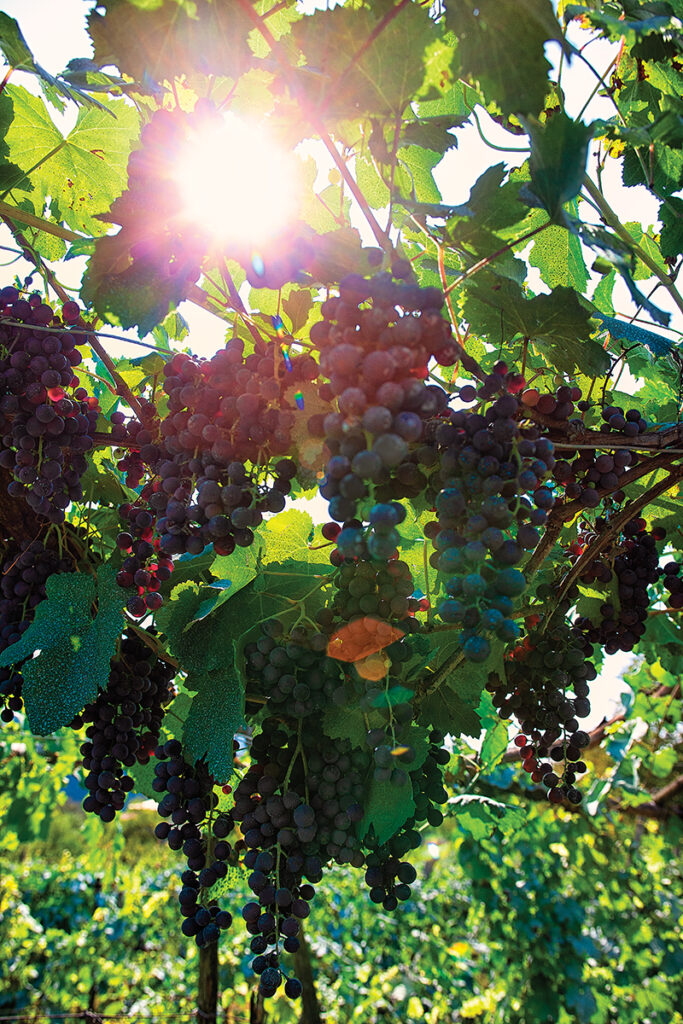
Giorgi Samanishvili: Based on my experience with Tsulukidze Tetra, I can say that it is very aromatic, if dry and made using traditional methods (keeping the pressed juice on dregs for one or more days and “racking” it after the start of fermentation). It also benefits from maceration.
Kakhaber Gordeziani: I make it the same way. I keep it on chacha for 4-5 hours, in the press under nitrogen, and then take it off of chacha.
Lado Uzunashvili: Does it increase its resistance to oxidization? Is it making this wine stronger for shelf life?
Kakhaber Gordeziani: It doesn’t increase it per se, but it protects it at the moment. This variety is especially prone to oxidization. We have one more variety in Racha called Kudurauli, which is two times more likely to get oxidized than Rachuli Tetra.
Lado Uzunashvili: At very single international conference I attended in the last few years, talks were about the phenomenon of blending dictated by the effects of the climate change.
Giorgi Samanishvili: Yes, and these topics have to be addressed.
Lado Uzunashvili: Obviously, there is a lot to do in Racha. To be more precise why, this is how it looks. On one hand, we are changing the established use of local varieties – we are switching from semi-sweets to dry wines. This, in itself, takes a lot from the wine – first, it shifts to another category, and second it requires a new blending policy between varieties. It looks, we will also face a situation, in which winemakers will need to establish a buffer zone, a %-age within which we will adjoin another varietal blending material. To me personally, under the given reality, there is more to consider in case of whites than reds.
David Chichua: The creation of the buffer phenomenon is a very interesting matter. It allows us to maintain stability over the years, by changing the proportion of varieties. We can do it with Aleksandrouli and Mujuretuli since they share the same character – they only differ in chemical parameters during the period of maturity. Adding Kabistoni to these varieties is a very good option, to add fresh berry tones to wine in high-sugar years (Aleksandrouli-Mujuretuli acquires heavier, stewed tones). This manipulation will allow us to bring the wine back to its standard position, even in the hottest of years.
Lado Uzunashvili: We can call a “stylistic buffer” if this sounded correct.
David Chichua: That’s a great term.
Lado Uzunashvili: We also need to consider that Georgia is a part of international legislation, which means that we can only add 15% of other varieties to wine without declaring them on the label. This 15% can serve as a huge buffer that can help us maintain new taste characteristics over the years. It is also possible to navigate between the percentages from 0 to 15, to help maintain the core taste of the principal variety in a given wine, and still meet the labelling requierements for varity, vintage and origin.
These strategic changes will not happen overnight, but over a few long years.
Giorgi Samanishvili: We also have to mention Dzelshavi (Imeretian, high-yield and easy-to-grow variety, spread throughout Racha). If we look through the literature, it is described as a low-quality variety that negatively impacts the quality of “Khvanchkara”. However, this opinion prevailed when semi-sweet wines were more popular. The times have changed, and nowadays, Dzeshlavi Racha is quite accepted.
Lado Uzunashvili: Generally speaking, stereotypes ruin a lot and if winemakers don’t fight them, they will never get desirable results. I think, that opinions belonging to a certain time in th epast, should not affect a potential of any variety today. As I mentioned earlier, we tried Dzelshavi in rose wine and the result could easily compete with popular rose wines of the World.
Giorgi Tevzadze: Dzelshavi is an Imeretian variety. Thanks to Racha, Imeretian winemakers started actively growing it. I don’t see a problem with growing this variety in both regions.
Lado Uzunashvili: Dejuiced Dzelshavi is an important part of co-fermentation with Mtsvane of Racha as it protects the wine from premature oxidization. You can treat this variety however you like, it is very hard to tire it, it has a very high resistance. As such, it gives a magnificent core to whites, gives them a mineral finish, increases aromas and mouth feel, and gives layers of taste. Dzelshavi is a variety with vast possibilities that can become an indispensable tool for locals in their tries to astonish wine lovers! Today we face a reality where winemakers have to share their experiences. We have to present our Country as a producer of the most interesting wines.
Years ago, when I returned to Georgia, I had an idea that was impossible to realize. We can now try to realize it in Racha: as winemakers, we can come together and make a “signature” blend, with a specific name and sign it on behalf of this region – put our taste and names at test. It will serve to showcase the potential of Racha. Individually, we all have our secrets and discoveries. United – we can come up with a very interesting case.
Sophia Lekishvili: This is a very interesting initiative and we fully support it. Racha wine should be a brand. I’m certain that it will find its place in the world. We are ready to participate in all the activities, with all the resources at our disposal.
Giorgi Tevzadze: I also like the initiative and I am fully ready to participate. Here will also be a good time to talk about barrels. We recently conducted a couple of interesting experiments, namely making wine from Racha varieties in American and French oak barrels. We closely monitored it and got very interesting results. I’d like to say that the wide array of Racha grape varieties can be used in many different ways. This region grants us this opportunity.
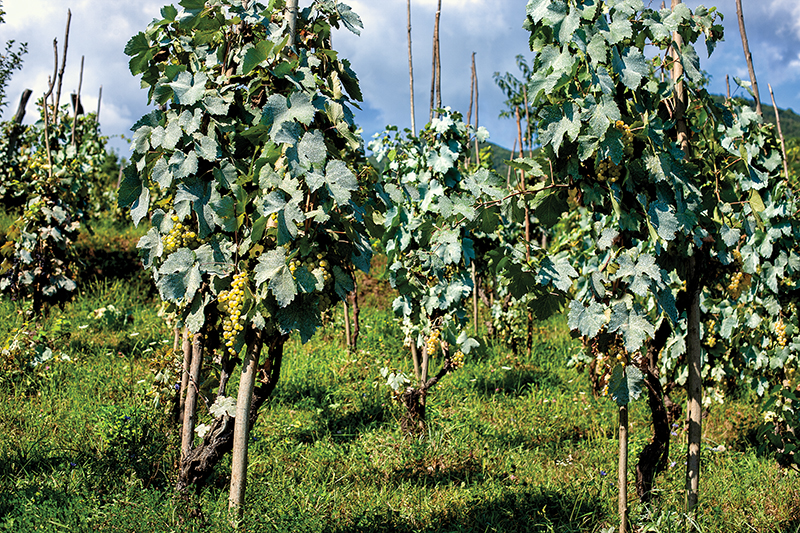
This gathering, initiated by Homeland of Wines magazine, is very important. I think we should meet permanently, visit Racha and discuss important issues that will bring prosperity to the region. Racha lacks exactly what we are doing here – discussing its capabilities, prospects, varieties, their protection, and development.

